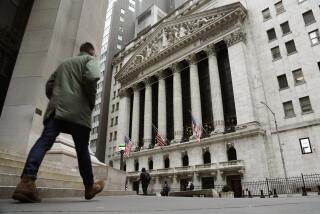Dow Drops Off 2.77 as Traders Mull Statistics
- Share via
NEW YORK — Stock prices slipped a bit from record levels today while traders assessed inflation statistics that came in close to expectations.
The Dow Jones average of 30 industrials, up 0.92 Tuesday to its second straight closing high, dropped 2.77 to 2,819.68.
Declining issues outnumbered advances by about 8 to 7 on the New York Stock Exchange, with 703 up, 792 down and 520 unchanged.
Big Board volume totaled 159.81 million shares, against 165.73 million in the previous session.
The NYSE’s composite index lost .17 to 193.14.
The Labor Department reported this morning that the consumer price index rose 0.2% in April, compared to 0.5% increases in the two preceding months.
Analysts said that reinforced recent evidence inflation was not reviving to the extent that traders had feared through much of the winter and early spring.
At the same time, they said, the market seemed largely to have anticipated the news with its rise to record highs earlier in the week.
It appeared that investors now are looking for signs that inflationary pressures and interest rates can continue their recent decline.
Bond prices fell amid profit-taking today despite the government’s reports on inflation.
The Treasury’s benchmark 30-year bond, which fell 13/32 point on Tuesday, was off 5/16 point, or about $3.10 per $1,000 face amount. Its yield, which rises when prices fall, edged up to 8.64% from 8.61% late Tuesday.
Market observers pointed to heavy selling in the futures market, which spilled over to the cash market. They suspected that some traders were taking profits.
Elizabeth Reiners, a vice president at Dean Witter Reynolds Inc., said there was “no reason, no information, no rumors” that would have prompted the selloff. “It might have been profit-taking,” she said.
Still others suggested that market participants were looking beyond the April inflation figure to the fact that inflation for the first four months of the year was running at a 6.8% seasonally adjusted annual rate, despite last month’s improvement. That’s up from 4.6% for all of 1989.
In the secondary market for Treasury bonds, prices of short-term governments were 3/8 point lower to 1/32 point higher, intermediate maturities between 1/32 point to 1/8 point lower and long-term issues were down by 3/16 point, according to the Telerate financial information service.
The movement of a point is equivalent to a change of $10 in the price of a bond with a $1,000 face value.
The Shearson Lehman Hutton daily Treasury bond index, which measures price movements on outstanding Treasury issues with maturities of a year or longer, fell 1.14 to 1,148.76.
Yields on three-month Treasury bills rose to 7.91% as the discount rate rose 2 basis points to 7.66%. Yields on six-month bills rose to 8.09% as the discount gained 1 basis point to 7.68%. Yields on one-year bills rose to 8.22% as the discount rose 2 basis points to 7.65%.
A basis point is one-hundredth of a percentage point. The yield is the annualized return on an investment in a Treasury bill. The discount is the percentage that bills are selling below the face value, which is paid at maturity.
More to Read
Inside the business of entertainment
The Wide Shot brings you news, analysis and insights on everything from streaming wars to production — and what it all means for the future.
You may occasionally receive promotional content from the Los Angeles Times.










